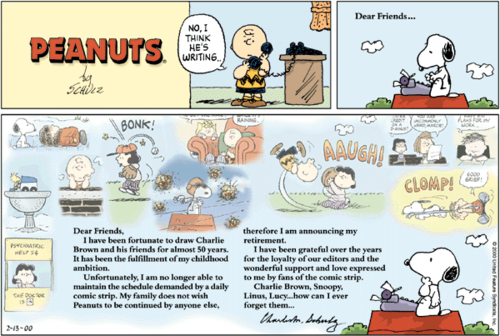Blog Archives
It’s The Greatest Comic Strip Ever, Charlie Brown!
Posted by WCPLtn
By Stacy Parish, Children’s Department
See what I did there with the title? And if you don’t, then you may have been living under a rock similar to the ones that Charlie Brown used to get in his trick-or-treat bag on Halloween. For the uninitiated, Peanuts is a syndicated comic strip written and illustrated by Charles M. Schulz that made its debut on October 2, 1950 in nine American newspapers: The Washington Post, The Chicago Tribune, The Minneapolis Tribune, The Allentown Morning Call, The Bethlehem Globe-Times, The Denver Post, The Seattle Times, The New York World-Telegram & Sun, and the Boston Globe. Original strips ran daily and Sundays until February 13, 2000, and at its peak, Peanuts appeared in more than 2,600 newspapers worldwide and was translated into 21 languages. The four-panel format set the standard for comic strips, and combined with other media and merchandise, Peanuts earned Schulz more than $1billion in his lifetime. Reprints are still syndicated and run in almost every U.S. newspaper.

The debut strip from October 2, 1950. From left to right: Charlie Brown, Shermy, and original Patty.
Peanuts originated from a weekly panel comic called Li’l Folks that appeared in Schulz’s hometown newspaper, the St. Paul Pioneer Press, from 1947 to1950. In addition to a round-headed kid that evolved into Charlie Brown, the early strip also featured a little dog that resembled the early 1950s version of Snoopy. Li’l Folks was dropped in early 1950, and later that year Schulz approached United Feature Syndicate with a collection of his best work. A deal was accepted, but a name change for the new strip was necessary in order to avoid confusion with two existing comic strips, Al Capp’s Li’l Abner and a comic titled Little Folks. The syndicate settled on Peanuts as the name for the new strip, and it was a name that Schulz always disliked. (Author’s random thought: I wonder if he got over that, when his earnings from Peanuts climbed into the millions.)
The final daily original Peanuts comic strip, in which Schulz announced his retirement, was published on Monday, January 3, 2000. It contained a farewell note to readers from Schulz, and had an illustration of Snoopy deep in thought atop his doghouse with his iconic typewriter. Schulz had drawn 5 extra Sunday strips which had yet to run, and the last-ever of these was published on February 13, 2000, the day after Schulz’s death at age 78 from complications from colon cancer. It incorporated a colorized version of Schulz’s farewell strip from January 3, several drawings from past strips, and the sweet note to Schulz’s faithful readers.

Final Peanuts Sunday strip, issued February 13, 2000, one day after the death of creator Charles M. Schulz.
Despite the end of the strip, Peanuts remains popular throughout multiple platforms –syndicated strips in daily and Sunday newspapers, television specials, books, theatrical productions, apparel and other merchandise, board games, amusement park characters, and perhaps the largest single venue of them all: the MetLife Insurance Company blimps, christened “Snoopy One” and “Snoopy Two.”
I have to confess, that in addition to having that pervasive earworm of a song in my head while I wrote this—you know, the song that Schroeder played on his magical piano in A Charlie Brown Christmas, that all the gang did their righteous dance moves to—I also had Bob Seger’s “Beautiful Loser” in my head. According to a 1986 interview by Seger in Creem magazine, that song is about people who set their goals so low that they never achieve anything of substance. It occurs to me that Peanuts’ central character, Charlie Brown, does just the opposite of that. He can’t fly a kite, win a baseball game, talk to the little red-haired girl without freaking out, or kick the football that Lucy heartlessly pulls away Every. Single. Time. Yet, against the mountain of evidence that suggests that the results will be the same, he keeps trying. He doesn’t give up. He perseveres.
The opinions expressed here are solely those of the author and not a reflection of Williamson County Public Library or its employees. She can occasionally be found sitting behind a desk in the Children’s Department offering psychiatric help, but she is no longer allowed to charge 5 cents for her services.
Posted in Authors and Books, History, Hot Topics
Tags: Charles M. Schulz, Charlie Brown, Peanuts, Snoopy, Stacy Parish
